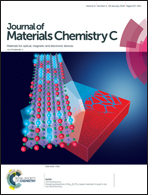Enhanced scratch resistance of self-assembled silica nanoparticle anti-reflection coatings†
Abstract
The layer-by-layer ionic self-assembly of silica nanoparticles (SiO2 NPs) and poly(allylamine hydrochloride) (PAH) can yield high-quality, tunable, and cost-effective anti-reflection coatings (ARCs). However, these purely ionic films lack the necessary scratch resistance for long-term stability. The addition of thermally-crosslinking polyelectrolytes, PAH and poly(acrylic acid) (PAA), can provide a solution to this challenge. The improved ARC design involves the formation of repeat-units of PAH/PAA/PAH/SiO2 interlayer ionic self-assembled multilayers (ISAM) films. This paper examines the associated effects resulting from the manipulation of the PAA pH to result in low to high chain charge densities (pH = 3.0 to 6.0, respectively). This PAA pH alteration dramatically shifts the films’ scratch resistance and anti-reflective properties in opposite directions. The films’ RMS surface roughness and surface morphology are also found to be substantially affected by the PAA pH variation, especially when the pH is in close proximity to the PAA pKa. In this report, characterization of these properties is obtained through UV-vis spectroscopy, ellipsometry, profilometry, field-emission scanning electron microscopy (FESEM), tribology, macro-scale scratch testing, and haze measurements. The development of covalent amide linkages in PAH/PAA films upon thermal crosslinking is confirmed through Fourier transform infrared spectroscopy. The primary goal of the study is an optimization of the trade-off between scratch resistance and anti-reflection properties within PAH/PAA/PAH/SiO2 interlayer ISAM ARCs through modification of the PAA pH. An optimal trade-off is found at a PAA pH value of 5.2.



 Please wait while we load your content...
Please wait while we load your content...